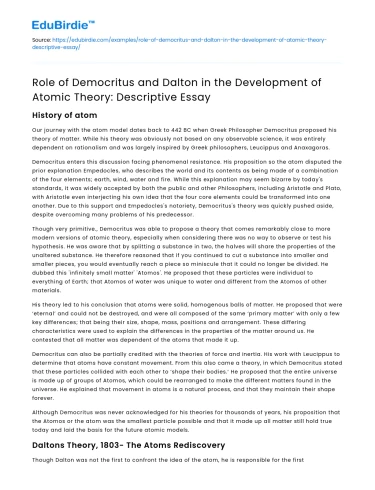History of atom
Our journey with the atom model dates back to 442 BC when Greek Philosopher Democritus proposed his theory of matter. While his theory was obviously not based on any observable science, it was entirely dependent on rationalism and was largely inspired by Greek philosophers, Leucippus and Anaxagoras.
Democritus enters this discussion facing phenomenal resistance. His proposition so the atom disputed the prior explanation Empedocles, who describes the world and its contents as being made of a combination of the four elements; earth, wind, water and fire. While this explanation may seem bizarre by today's standards, it was widely accepted by both the public and other Philosophers, including Aristotle and Plato, with Aristotle even interjecting his own idea that the four core elements could be transformed into one another. Due to this support and Empedocles's notoriety, Democritus's theory was quickly pushed aside, despite overcoming many problems of his predecessor.
Save your time!
We can take care of your essay
- Proper editing and formatting
- Free revision, title page, and bibliography
- Flexible prices and money-back guarantee
Though very primitive., Democritus was able to propose a theory that comes remarkably close to more modern versions of atomic theory, especially when considering there was no way to observe or test his hypothesis. He was aware that by splitting a substance in two, the halves will share the properties of the unaltered substance. He therefore reasoned that if you continued to cut a substance into smaller and smaller pieces, you would eventually reach a piece so miniscule that it could no longer be divided. He dubbed this 'infinitely small matter' 'Atomos'. He proposed that these particles were individual to everything of Earth; that Atomos of water was unique to water and different from the Atomos of other materials.
His theory led to his conclusion that atoms were solid, homogenous balls of matter. He proposed that were ‘eternal’ and could not be destroyed, and were all composed of the same ‘primary matter’ with only a few key differences; that being their size, shape, mass, positions and arrangement. These differing characteristics were used to explain the differences in the properties of the matter around us. He contested that all matter was dependent of the atoms that made it up.
Democritus can also be partially credited with the theories of force and inertia. His work with Leucippus to determine that atoms have constant movement. From this also came a theory, in which Democritus stated that these particles collided with each other to ‘shape their bodies.’ He proposed that the entire universe is made up of groups of Atomos, which could be rearranged to make the different matters found in the universe. He explained that movement in atoms is a natural process, and that they maintain their shape forever.
Although Democritus was never acknowledged for his theories for thousands of years, his proposition that the Atomos or the atom was the smallest particle possible and that it made up all matter still hold true today and laid the basis for the future atomic models.
Daltons Theory, 1803- The Atoms Rediscovery
Though Dalton was not the first to confront the idea of the atom, he is responsible for the first contemporary theory, as it was the first theory based on experiments and research, making it the first scientific theory.
Dalton discovered an atomic theory that could help explain common patterns in chemistry, such as Proust's study of tin oxides, from which he developed 'the law of multiple proportions'.
Daltons believed he could also explain other phenomena using atomic theory, notably, why water absorbed different gasses in different proportions. He hypothesized this was due to the different complexities of the gasses, and their differing mass. He conducted a series of experiments to test and provide evidence for his theory, determining gases had to be comprised of particles in constant motion. Additionally, Dalton investigated compounds. He demonstrated that a compound will always consist of them elements in the same ratio, that was entirely unique to said compound. Dalton thus reasoned that this could only be true of these compounds were made of miniscule particles that could be rearranged infinitely. This long period of experiments set the basis for his theory of the atom.
Daltons model of the atom pulls upon many ideas set up by Democritus, and expands of them. He stated atoms were the smallest particles of matter, and the building blocks of every substance. They cannot be destroyed or created, and they are indivisible. He suggested that every chemical element is composed of atoms, each of an individual, unique type. He maintained that atoms could not be destroyed or altered, despite being able to combine to form more complex structures. Dalton also propped that all atoms within a given element had the same mass, which was dependent on each element. This theory was soon widely accepted.
References
- Atomic model of Democritus: antecedents, characteristics, postulates â WARBLETONCOUNCIL (https:warbletoncouncil.orgmodelo-atomico-de-democrito-4533#menu-1)
- What is the atomic model of Democritus? âCHEMESTRYRACK (https:chemistryrack.comatomic-model-of-democritus#:~:text=The main characteristics of the atomic model of, vary depending on the grouping of the atoms.)
- Early Ideas about Matter: From Democritus to Dalton â VISIONLEARNING (https:www.visionlearning.comenlibraryChemistry1Early-Ideas-about-Matter49)






 Stuck on your essay?
Stuck on your essay?

